
Al Qamar Academy, Chennai, Grade 4
February- March 2017
Small Science – Class 4
Unit 3 -Water
Chapter 6 – Water and life
Water and life
Aunty read us the story of Mini and Apu and the fish tank. We have a fish tank in school too. Aunty reminded us that before the fish had been put into the water, Ishal had noticed small wriggly worms — mosquito larvae. We discussed how we have seen the water turn murky and greenish when the tank hasn’t been cleaned for some time.
Aunty brought in some yellow bell flowers today. We crushed them between our fingers — a small amount of liquid came out. Just a little bit. Aunty also brought in a small weed. She asked us to crush the roots and tell what we felt. Afsheen said it felt a bit wet. Aunty also cut a small gash in an Aloe Vera plant — ooh there was a lot of slimy thick liquid there.
Then Rafia Aunty cut up a brinjal and scooped out the inside part. She sprinkled salt on the two pieces. Aneesa Aunty asked us to observe the brinjal halves. They were white and had small dots — the seeds. After 5 minutes, she asked us to see it again — this time there was a small pool of water in the brinjal halves. We saw it again after 10 minutes and then 15 minutes. Each time there was much more water. Umar pointed out that a lot of water comes out of a watermelon when we cut it.
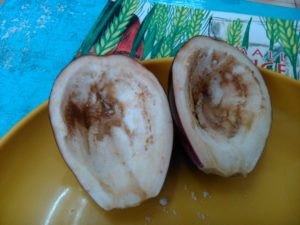
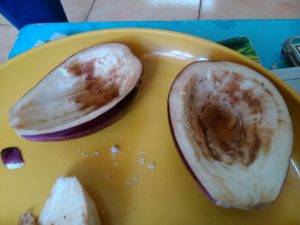
We also took some Yellow Bell flowers and put them out. After some time, the flowers looked smaller and wilted.
Aunty asked Ameeth to tie a plastic bag around the leaves of the potted plant we have outside the entrance. When she asked us to see if after some time, we noticed droplets of water inside the bag.
Aunty asked us where all this water was coming from in the plants? “Roots” said one of us, “The plant sucks it up from the ground through the roots.” We realised that leaves, stems and flowers, all have water going into them and it is continuously going out too.
“Do seeds have any water?” Aunty asked. Even dried seeds which are not taking in water have some water already in them. After all, they are living!
Aunty then taught us about stomata and how the leaf works.
Today, we broke up into groups. Aunty asked us to make a balance with a ruler, pencil and matchboxes like we had done in Grade 3. This took a lot of time because the ruler doesn’t balance easily unless you put it on exactly the right spot. Finally, we all got done. Aunty gave 1 team a set of dark pink flowers and the other 3 groups, Yellow Bell flowers. She asked us to put the one flower each in each of the matchboxes till the whole thing balanced again.
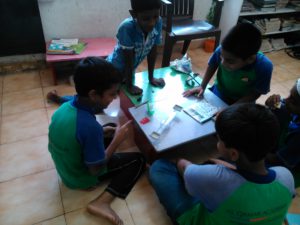

We then put one flower in a bowl of water and one beside it.
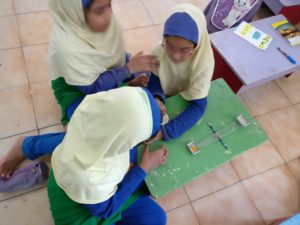
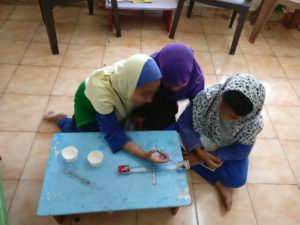
After 4 hours, we checked the flowers’ weights using our balances. All the teams found that the flower kept in water was heavier. The Yellow Bells needed 2 drops of water to balance them, but the dark pink flower group needed 20!!
We discussed what had happened. Afsheen said that the flower in the water bowl absorbed water, and the one outside dried up. Both the flowers — the one in the water and one outside it — must have given out water. But the flower which was in the bowl had its lost water replaced by water from the bowl. Someone observed that the pink flower which was not kept in the water looked very dry — drier than the Yellow Bells. It must be losing water very quickly.
Today Rafia Aunty brought more flowers to the classroom. She put a few drops of ink in a glass and mixed it with water. Then we put a Yellow Bell into this mixture and observed it after an hour. At first the ink didn’t seem to have climbed much as the outer stem looked dark blue only at the tip which was immersed in the ink. But we suspected there was some colour inside as the green stem looked a slightly different colour. Sure enough, when sliced it we saw that the ink had risen approximately an inch inside the stem.
One student said the stem was like a tree trunk or tube – it had absorbed the ink on the inside while the outside didn’t show much ink. Safwan noticed that the absorption was jagged and uneven — light on top, darker in the middle and darkest at the bottom. We predicted that if we kept the flower for longer the whole flower may turn blue. Another student predicted that the flower would turn three shades with lightest at the top.
Today we suffered and sweated! First Aunty asked us to breathe out on a window pane. We saw little droplets forming there. We discussed how when we go to hill stations, we can see our breath as a mist coming out of our mouths and noses.
Then Aunty gave us each a plastic bag. We put our hands inside and secured it with a rubber band. That was when we suffered. Our hands started getting so wet and drippy. We complained, but Aunty asked us to be patient and keep the bags on for some more time. Finally, after 5 minutes we removed the bags. Our hands were completely sweaty.
Aunty gave us homework. Our parents had to take us to visit a pond or a backwater over the weekend. When we came back, only a few of us reported that our parents had taken us. They described the ponds — dirty, green. They saw seaweed and mosquito larvae. Shafeeq lives near ponds so his dad brought us a bottle of pond water. We filled another bottle with clear water. We kept observing these for a few days. After a few days, we saw that the bottle with pond water was looking murkier than before. There were things at the bottom — like green strings or balls.
Ameeth took the responsibility for sprouting some moong seeds for our next experiment. After a few days, he gave us three cups with a moong plant in each. Ameeth was made in charge of watering these plants. He watered one just right, another one he gave a lot of water and the third he didn’t water. After a few days, we saw that the plant with no water was completely shrivelled and droopy. But both the others were fine — even the one which was getting a lot of water. Aunty said that maybe moong plants do fine with a lot of water.
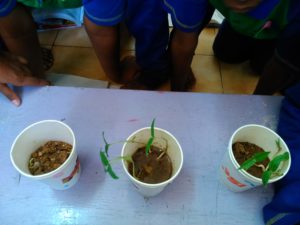
Today some of us brought in things which are not living but need water to work properly. Umar brought a plastic bottle — he said if we shoot water inside it, the bottle would shoot out like a jet.
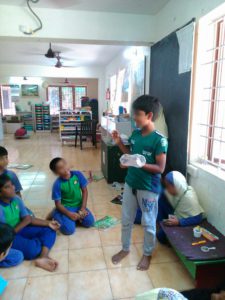
Safwan brought his water wheel — which we had learnt about in the previous chapter.
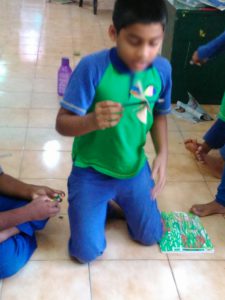
Ameeth smartly brought in his moong grains — he said, “They aren’t living, but need water to become living.” That caused a lot of confusion — how could something that is non-living become alive?? Whole moong sprouts, so it must be living. And the seeds before they are soaked? They must be living too. Actually there is a small living part inside every seed called the “endosperm” which is alive and even respires, very slowly.
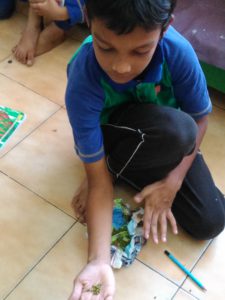
Whole moong sprouts, so it must be living!
Aahil brought a part of a brick — he said it needs water to work. That’s right. We do need to soak bricks in water before using them to build walls.
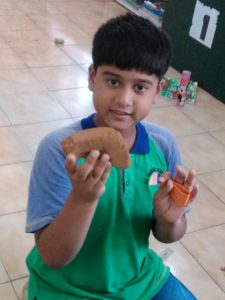
We had an interesting discussion on whether a rose plant could grow in water like a lotus plant or could it grow in a desert. Some people said a rose plant can’t grow in a desert as there is no water. It will wilt. But then someone said it might grow in a cold desert — there is condensation at night. We wondered if a plant can control the amount of water it can take in. Rafia Aunty asked us to guess. Someone said that a plant can control the amount of water intake, but not during floods. Another person wanted to know if the lotus stem touches the soil at the bottom of a pond, so they could decide if a rose could grow in pond too. But then, someone said, a rose plant is too heavy — it can’t float in water like a lotus plant does, it would sink. Besides, lotus leaves are special because water just rolls off instead of wetting them. We discussed about animals — whether they could live outside their habitats — if animals couldn’t, then perhaps nor could plants. We need to find out more.
Teacher’s Observations
- Interestingly some children observed that the flower left out in the sun lost water, but when it came to explaining why the flower put in water weighed more than the dry counterpart, they said it was because the flower absorbed water and didn’t remember that the flower kept outside also lost water. Their learning from the previous class, that absorbed water is also given out continuously, was not integrated into their explanation. We could have discussed whether the two flowers weighed more or less than they did originally, but this does seem to be a complex argument for students to construct.
- When asked to state why they thought animals have or don’t have water in their bodies, they were unanimous in stating that animals had water in their bodies. They gave some reasons — all animals drink water, animals have blood — which is made of water.
- Unfortunately, many parents are unable to take the children for out-of-class observations — whether sunrise / sunset on the beach or local ponds (which are abundant in ECR, Chennai). Hence only a few children reported what they saw in water. Perhaps, as has been done in the past, the school should organise an outing for this purpose.
- Children, however, could report animals / plants in water — maybe through what they’ve read or heard — the lotus was the most common response as a water plant. Since lotus aren’t common here, this observation was obviously second hand or cultural knowledge.
- The children could guess that animals and grubs who don’t drink water get the water from the food they eat. We had already discussed that even dried grains have some water in them.
- When asked about microbes that live in pond water, some children said they didn’t know what microbes were! Even though they had studied microbes in this and the previous unit. I guess they just forgot. Only a few went back to the textbook to this chapter and read it to answer the question!
- In the Exercises section of the workbook, children had to draw a plant which has been given adequate water, no water and too much water. We did the experiment in class for the children to see what happens. Contrary to expectation, the moong plant in too much water was as vibrant as the one with adequate water. The reason could be that we didn’t observe over a sufficiently long period of time. Interestingly, some children failed to make “real” observations of the moong plants, but rather drew what they expected to see. One drew droopy plants for both the “no water” and “too much water” cases, another showed water pouring out of the glass from all sides.
- When asked why they thought water leaves a plant, some children simply said, “It evaporates.” They didn’t connect the physical observations we had been doing with wilted flowers/plants, or tying a plastic bag around some leaves of a plant.
- In thinking about which parts of the plant have water, children could comfortably give reasons for root / stem / leaf / flower etc., but had issues in thinking about seeds having water. Only one child stated, “It is sometimes wet.” Another said, “How else would it sprout?” But in the very next section, one child wrote that a peanut has water because “we get oil from it.” Another gave the all-encompassing “Water is in everything.” Others left it blank.
- There were interesting responses about roti having water where children connected that water is added to the dough, hence the roti, though it is dry, does have water. None said that atta may have water too.
- Children did struggle with calculating the amount of water in their body — perhaps because they aren’t very comfortable with fractions yet.
- Again, the ‘Ask a question’ section got very superficial responses. We need to think how to integrate this section into the classroom discussion and make a wall board of questions. In an earlier year, we had a question box into which children put their questions. The incentive — we’d get a “real” scientist to answer these. Which happened as I sent the questions to Eklavya and got wonderful, patient and detailed responses.
- Overall, class discussions elicited wonderful responses, which then translated to better responses in the workbook.
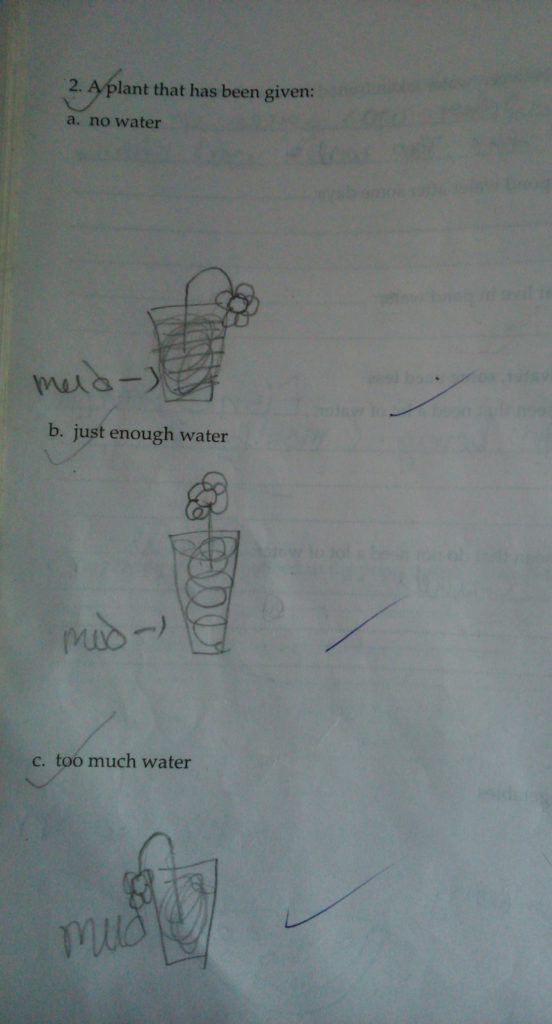
Drawing the expected not actual result
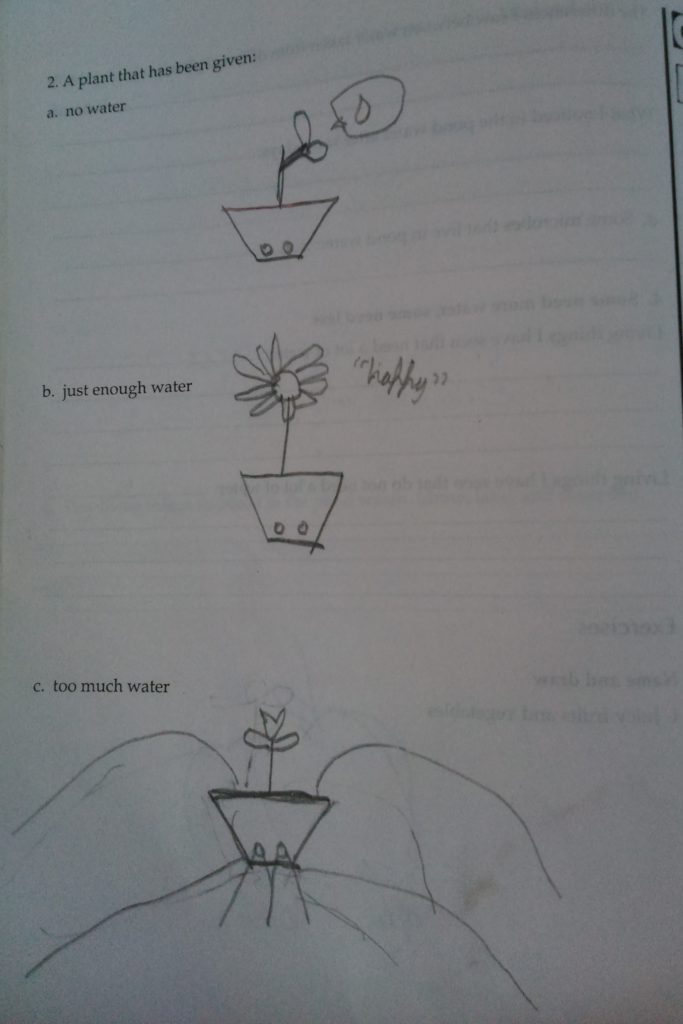
Drawing an imagined result
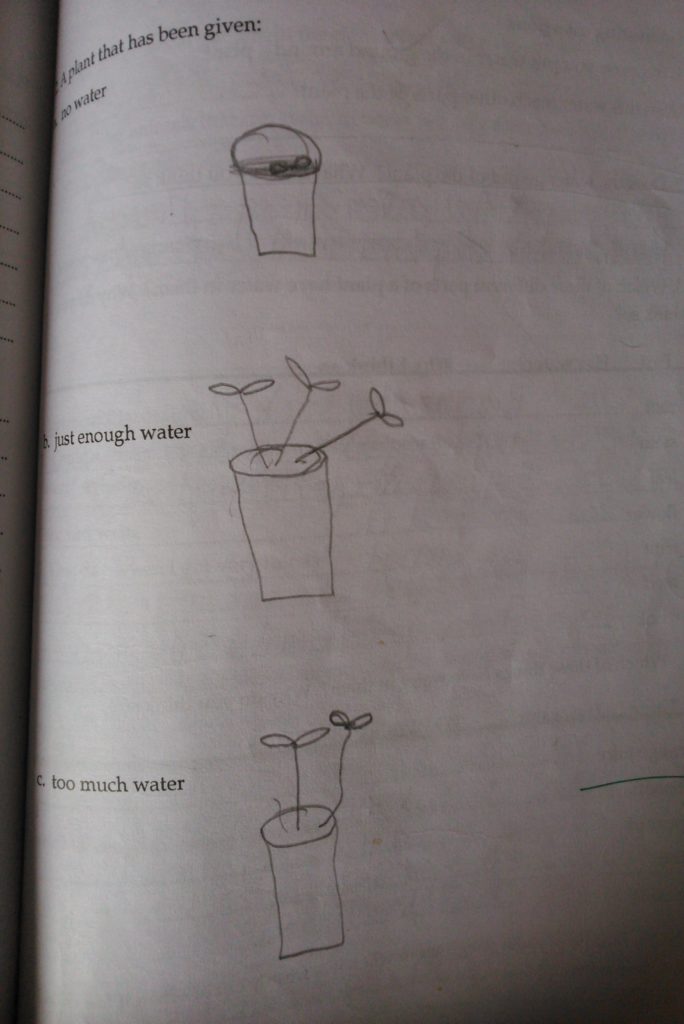
Drawing an observed result
Aneesa Jamal
Correspondent, AQA



